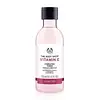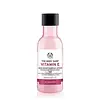What's inside
What's inside
 Key Ingredients
Key Ingredients

 Benefits
Benefits

 Concerns
Concerns

 Ingredients Side-by-side
Ingredients Side-by-side

Water
Skin ConditioningGlycerin
HumectantPPG-26-Buteth-26
Skin ConditioningPEG-40 Hydrogenated Castor Oil
EmulsifyingPhenoxyethanol
PreservativePolysorbate 20
EmulsifyingDiglycerin
HumectantTocopheryl Acetate
AntioxidantPotassium Sorbate
PreservativeCarbomer
Emulsion StabilisingXanthan Gum
EmulsifyingDisodium EDTA
Triticum Vulgare Germ Oil
EmollientParfum
MaskingBenzyl Benzoate
AntimicrobialSodium Hydroxide
BufferingCitric Acid
BufferingHydroxycitronellal
PerfumingLimonene
PerfumingGeraniol
PerfumingLinalool
PerfumingCitronellol
PerfumingCinnamyl Alcohol
PerfumingWater, Glycerin, PPG-26-Buteth-26, PEG-40 Hydrogenated Castor Oil, Phenoxyethanol, Polysorbate 20, Diglycerin, Tocopheryl Acetate, Potassium Sorbate, Carbomer, Xanthan Gum, Disodium EDTA, Triticum Vulgare Germ Oil, Parfum, Benzyl Benzoate, Sodium Hydroxide, Citric Acid, Hydroxycitronellal, Limonene, Geraniol, Linalool, Citronellol, Cinnamyl Alcohol
Water
Skin ConditioningGlycerin
HumectantPropanediol
SolventImperata Cylindrica Root Extract
Skin ConditioningPhenoxyethanol
PreservativeCaprylyl Glycol
EmollientAcrylates/C10-30 Alkyl Acrylate Crosspolymer
Emulsion StabilisingPPG-26-Buteth-26
Skin ConditioningArgania Spinosa Kernel Oil
EmollientTocopheryl Acetate
AntioxidantTriticum Vulgare Germ Oil
EmollientPotassium Hydroxide
BufferingSodium Acrylate/Sodium Acryloyldimethyl Taurate Copolymer
Emulsion StabilisingPEG-40 Hydrogenated Castor Oil
EmulsifyingBetaine
HumectantDisodium EDTA
Sodium Hyaluronate
HumectantXanthan Gum
EmulsifyingIsohexadecane
EmollientCarbomer
Emulsion StabilisingAloe Barbadensis Leaf Juice Powder
Skin ConditioningPolysorbate 80
EmulsifyingSodium Citrate
BufferingParfum
MaskingPEG-30 Dipolyhydroxystearate
EmulsifyingTrideceth-6
EmulsifyingSorbitan Oleate
EmulsifyingBenzyl Benzoate
AntimicrobialHydroxycitronellal
PerfumingCitric Acid
BufferingBiotin
AntiseborrhoeicWater, Glycerin, Propanediol, Imperata Cylindrica Root Extract, Phenoxyethanol, Caprylyl Glycol, Acrylates/C10-30 Alkyl Acrylate Crosspolymer, PPG-26-Buteth-26, Argania Spinosa Kernel Oil, Tocopheryl Acetate, Triticum Vulgare Germ Oil, Potassium Hydroxide, Sodium Acrylate/Sodium Acryloyldimethyl Taurate Copolymer, PEG-40 Hydrogenated Castor Oil, Betaine, Disodium EDTA, Sodium Hyaluronate, Xanthan Gum, Isohexadecane, Carbomer, Aloe Barbadensis Leaf Juice Powder, Polysorbate 80, Sodium Citrate, Parfum, PEG-30 Dipolyhydroxystearate, Trideceth-6, Sorbitan Oleate, Benzyl Benzoate, Hydroxycitronellal, Citric Acid, Biotin
 Reviews
Reviews

Ingredients Explained
These ingredients are found in both products.
Ingredients higher up in an ingredient list are typically present in a larger amount.
Benzyl Benzoate is usually created from the condensation of benzoic acid and benzyl alcohol. It is used as a preservative, solvent, and has a floral/balsamic scent in large amounts.
As a preservative, Benzyl Benzoate works against bacteria and fungus. It is often used to treat scabies and lice in medicine.
Solvents are used to keep ingredients together in a product. They can help dissolve ingredients to stable bases or help evenly distribute ingredients throughout the product.
Due to its fragrance, Benzyl Benzoate can be sensitizing and may cause contact dermatitis. It is a known EU allergen. We recommend speaking with a professional if you have any concerns.
Benzyl Benzoate can be naturally found in cranberries and peaches.
Learn more about Benzyl BenzoateCarbomer is a polymer of acrylic acid. Its main role is to create a gel consistency.
A high amount of carbomer can cause pilling or balling up of products. Don't worry, most products contain 1% or less of carbomer.
Citric Acid is an alpha hydroxy acid (AHA) naturally found in citrus fruits like oranges, lemons, and limes.
Like other AHAs, citric acid can exfoliate skin by breaking down the bonds that hold dead skin cells together. This helps reveal smoother and brighter skin underneath.
However, this exfoliating effect only happens at high concentrations (20%) which can be hard to find in cosmetic products.
Due to this, citric acid is usually included in small amounts as a pH adjuster. This helps keep products slightly more acidic and compatible with skin's natural pH.
In skincare formulas, citric acid can:
While it can provide some skin benefits, research shows lactic acid and glycolic acid are generally more effective and less irritating exfoliants.
Most citric acid used in skincare today is made by fermenting sugars (usually from molasses). This synthetic version is identical to the natural citrus form but easier to stabilize and use in formulations.
Read more about some other popular AHA's here:
Learn more about Citric AcidDisodium EDTA plays a role in making products more stable by aiding other preservatives.
It is a chelating agent, meaning it neutralizes metal ions that may be found in a product.
Disodium EDTA is a salt of edetic acid and is found to be safe in cosmetic ingredients.
Learn more about Disodium EDTAGlycerin is already naturally found in your skin. It helps moisturize and protect your skin.
A study from 2016 found glycerin to be more effective as a humectant than AHAs and hyaluronic acid.
As a humectant, it helps the skin stay hydrated by pulling moisture to your skin. The low molecular weight of glycerin allows it to pull moisture into the deeper layers of your skin.
Hydrated skin improves your skin barrier; Your skin barrier helps protect against irritants and bacteria.
Glycerin has also been found to have antimicrobial and antiviral properties. Due to these properties, glycerin is often used in wound and burn treatments.
In cosmetics, glycerin is usually derived from plants such as soybean or palm. However, it can also be sourced from animals, such as tallow or animal fat.
This ingredient is organic, colorless, odorless, and non-toxic.
Glycerin is the name for this ingredient in American English. British English uses Glycerol/Glycerine.
Learn more about GlycerinHydroxycitronellal is a fragrance created from citronellal. The smell of hydroxycitronellal is often described as "citrus-like" or "melon-like".
Hydroxycitronellal is a known EU allergen and may cause irritation when applied to the skin.
Parfum is a catch-all term for an ingredient or more that is used to give a scent to products.
Also called "fragrance", this ingredient can be a blend of hundreds of chemicals or plant oils. This means every product with "fragrance" or "parfum" in the ingredients list is a different mixture.
For instance, Habanolide is a proprietary trade name for a specific aroma chemical. When used as a fragrance ingredient in cosmetics, most aroma chemicals fall under the broad labeling category of “FRAGRANCE” or “PARFUM” according to EU and US regulations.
The term 'parfum' or 'fragrance' is not regulated in many countries. In many cases, it is up to the brand to define this term.
For instance, many brands choose to label themselves as "fragrance-free" because they are not using synthetic fragrances. However, their products may still contain ingredients such as essential oils that are considered a fragrance by INCI standards.
One example is Calendula flower extract. Calendula is an essential oil that still imparts a scent or 'fragrance'.
Depending on the blend, the ingredients in the mixture can cause allergies and sensitivities on the skin. Some ingredients that are known EU allergens include linalool and citronellol.
Parfum can also be used to mask or cover an unpleasant scent.
The bottom line is: not all fragrances/parfum/ingredients are created equally. If you are worried about fragrances, we recommend taking a closer look at an ingredient. And of course, we always recommend speaking with a professional.
Learn more about ParfumPeg-40 Hydrogenated Castor Oil is derived from castor oil and polyethylene glycol (PEG). It is used as a emollient and emulsifier.
As an emulsifier, it helps prevent ingredients from separating. It also helps make the other ingredients more soluble; it is often used to solubilize fragrances. This increases spreadability and elongates shelf life in a product.
Emollients help soothe and soften the skin. They do this by creating a protective film on your skin. This barrier helps trap moisture and keeps your skin hydrated. Emollients may be effective at treating dry or itchy skin.
This ingredient may or may not be vegan, depending on the source.
Peg-40 Hydrogenated Castor Oil may not be fungal-acne safe. We recommend speaking with a professional if you have any questions or concerns.
Learn more about PEG-40 Hydrogenated Castor OilPhenoxyethanol is a preservative that has germicide, antimicrobial, and aromatic properties. Studies show that phenoxyethanol can prevent microbial growth. By itself, it has a scent that is similar to that of a rose.
It's often used in formulations along with Caprylyl Glycol to preserve the shelf life of products.
We don't have a description for PPG-26-Buteth-26 yet.
Tocopheryl Acetate is AKA Vitamin E. It is an antioxidant and protects your skin from free radicals. Free radicals damage the skin by breaking down collagen.
One study found using Tocopheryl Acetate with Vitamin C decreased the number of sunburned cells.
Tocopheryl Acetate is commonly found in both skincare and dietary supplements.
Learn more about Tocopheryl AcetateWheatgerm oil is a yellow/reddish oil derived from germs on the common wheat. It is rich in Vitamin E, an ingredient with many skin benefits.
About 80% of the oil is made up of fatty acids. The majority of these include linoleic acid and linolenic acid.
Studies show this oil can aid in wound healing and soothing inflammation.
This ingredient may not be acne or fungal-acne safe.
Sometimes, the Vitamin E derived from wheat germ can contain gluten. However, most plant derived oil is processed to remove all proteins.
Learn more about Triticum Vulgare Germ OilWater. It's the most common cosmetic ingredient of all. You'll usually see it at the top of ingredient lists, meaning that it makes up the largest part of the product.
So why is it so popular? Water most often acts as a solvent - this means that it helps dissolve other ingredients into the formulation.
You'll also recognize water as that liquid we all need to stay alive. If you see this, drink a glass of water. Stay hydrated!
Learn more about WaterXanthan gum is used as a stabilizer and thickener within cosmetic products. It helps give products a sticky, thick feeling - preventing them from being too runny.
On the technical side of things, xanthan gum is a polysaccharide - a combination consisting of multiple sugar molecules bonded together.
Xanthan gum is a pretty common and great ingredient. It is a natural, non-toxic, non-irritating ingredient that is also commonly used in food products.
Learn more about Xanthan Gum